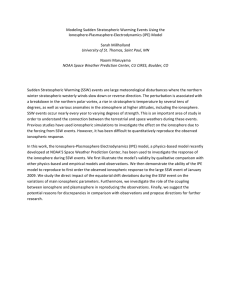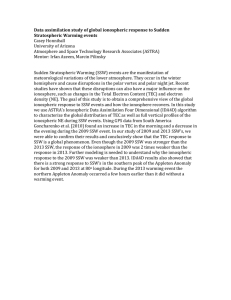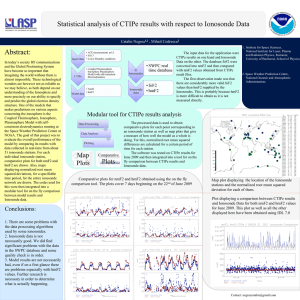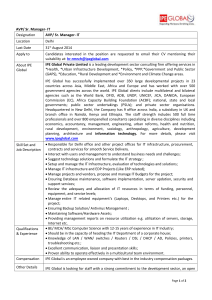Document 12625243
advertisement
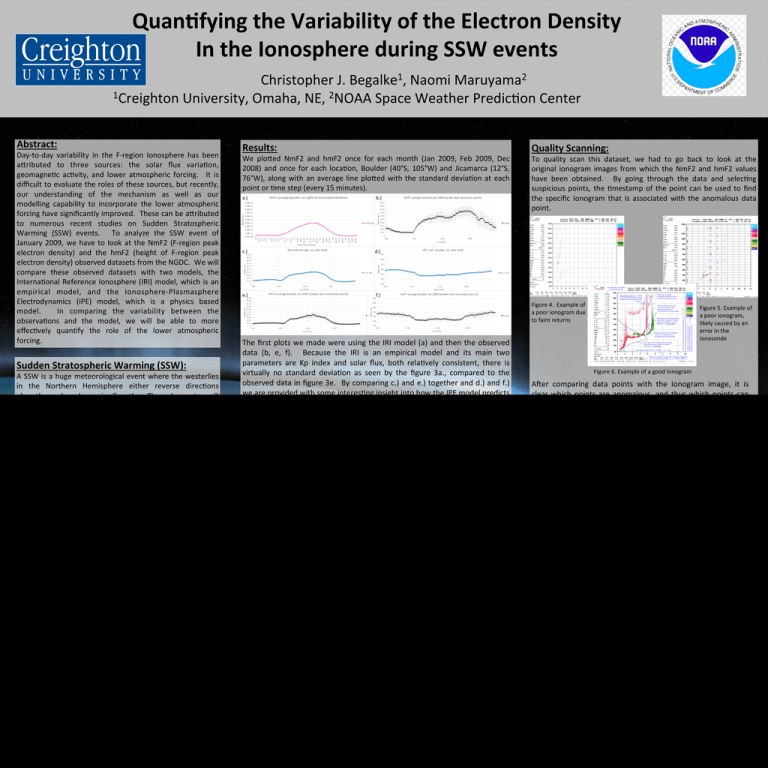
Quan%fying the Variability of the Electron Density In the Ionosphere during SSW events 1 2 Christopher J. Begalke , Naomi Maruyama 1Creighton University, Omaha, NE, 2NOAA Space Weather PredicEon Center Abstract: Results: Day-­‐to-­‐day variability in the F-­‐region Ionosphere has been aKributed to three sources: the solar flux variaEon, geomagneEc acEvity, and lower atmospheric forcing. It is difficult to evaluate the roles of these sources, but recently, our understanding of the mechanism as well as our modelling capability to incorporate the lower atmospheric forcing have significantly improved. These can be aKributed to numerous recent studies on Sudden Stratospheric Warming (SSW) events. To analyze the SSW event of January 2009, we have to look at the NmF2 (F-­‐region peak electron density) and the hmF2 (height of F-­‐region peak electron density) observed datasets from the NGDC. We will compare these observed datasets with two models, the InternaEonal Reference Ionosphere (IRI) model, which is an empirical model, and the Ionosphere-­‐Plasmasphere Electrodynamics (IPE) model, which is a physics based model. In comparing the variability between the observaEons and the model, we will be able to more effecEvely quanEfy the role of the lower atmospheric forcing. We ploKed NmF2 and hmF2 once for each month (Jan 2009, Feb 2009, Dec 2008) and once for each locaEon, Boulder (40°S, 105°W) and Jicamarca (12°S, 76°W), along with an average line ploKed with the standard deviaEon at each point or Eme step (every 15 minutes). c.) d.) e.) f.) The first plots we made were using the IRI model (a) and then the observed data (b, e, f). Because the IRI is an empirical model and its main two parameters are Kp index and solar flux, both relaEvely consistent, there is virtually no standard deviaEon as seen by the figure 3a., compared to the observed data in figure 3e. By comparing c.) and e.) together and d.) and f.) we are provided with some interesEng insight into how the IPE model predicts the NmF2 and hmF2 values. The similarity between the two plots is very important. It shows that the IPE model can accurately depict the NmF2 and hmF2 values, both of which are quite characterisEc of the large scale structure of the Ionosphere. While there is only one day (just before onset of SSW) in the IPE model, the absence of any anomalous points would likely lead to much less variaEon than what is seen in the observed data. Comparing Jan 2009 (SSW) to other months, we have yet to find definiEve differences between the SSW event and non-­‐SSW events. This may be due to the inconsistency of the data. A SSW is a huge meteorological event where the westerlies in the Northern Hemisphere either reverse direcEons abruptly or slow down significantly. The polar vortex will weaken or even break down completely. The warming aspect comes from a rise in stratospheric temperature by tens of degrees. A key mechanism in SSW events is the propaga%on of planetary waves upward from the troposphere and their corresponding non-­‐linear interac%on with the zonal mean flow. The potenEal benefit of this connecEon is the ability to predict the SSW a few days in advance, allowing for potenEal ionospheric forecasEng. The ionosphere is a casing of free electrons and ions that surrounds the earth from roughly 60 km to 800 km. There are two regions in the Ionosphere of note, but for the purposes of this research, the focus will be on the F2 region (Figure 1). Focusing on the F2 region is criEcal because it is furthest away from the recombinaEon effects that could potenEally conceal the lower atmospheric forcing effects. The F2 region is driven by dynamics, more so than chemistry. NmF2 and HmF2 (Figure 2) are two parameters that can be indicaEve of the large scale structure of the Ionosphere. b.) To quality scan this dataset, we had to go back to look at the original ionogram images from which the NmF2 and hmF2 values have been obtained. By going through the data and selecEng suspicious points, the Emestamp of the point can be used to find the specific Ionogram that is associated with the anomalous data point. Figure 4. Example of a poor ionogram due to faint returns Sudden Stratospheric Warming (SSW): Ionosphere: a.) Quality Scanning: Methodology: NOAA’s NaEonal Centers for Environmental InformaEon, formerly the NaEonal Geophysical Center (NGDC) provides archived Ionosonde Data for the public. Through the Space Physics InteracEve Data Resource (SPIDR) porEon of the NGDC, they provide ionosonde data across the world. There is no quality scan before this data gets disseminated, providing addiEonal challenges in understanding the data. Here are some examples of the raw data ploKed, with clearly anomalous points: Figure 6. Example of a good Ionogram Ajer comparing data points with the Ionogram image, it is clear which points are anomalous, and thus which points can be exempted in an aKempt to reduce the variaEon. Conclusions: We have determined the importance of quality scanning data in order to make sense of the findings. When comparing the IPE model and observed data, we see significant similariEes. This means that with the WAM model driving the IPE model, the IPE model can accurately depict past events, and thus may be able to forecast events in the future. When it comes to the variaEon in electron density, the IPE model can reduce the variability and may be able to quanEfy the effects of lower atmospheric forcing. We also did confirm an increase in electron density at low laEtudes compared to mid laEtudes. Future Work: To conEnue this research more effecEvely, a code must be wriKen to take out anomalous points from observed data. Then we will conEnue running the IPE model for mulEple days and mulEple staEons to compare the variability with the goal of quanEfying the variability of electron density. Acknowledgements: Special thanks to: LASP, Erin Wood and Marty Snow JusEn Mabie, Catalin Negrea, Mariangel Fedrizzi NaEonal Geophysical Data Center (NGDC) for ionosonde data InternaEonal Reference Ionosphere (IRI) for model data References: • • • Figure 1. VerEcal profile of atmosphere as a whole Figure 2. VerEcal profile of the F region. In the NmF2 plot, it is clear that the large spike in the data is anomalous and there are numerous anomalous points in the hmF2 plot as well (note: UT Eme here). Since there is no quality scan in the data, it must be done manually to get rid of the variaEon in the plots. Figure 5. Example of a poor ionogram, likely caused by an error in the ionosonde • Chau, J. L., L. P. Goncharenko, B. G. Fejer, and H.-­‐L. Liu (2011), Equatorial and Low LaEtude Ionospheric Effects during Sudden Stratospheric Warming Events, Space Sci. Rev., doi:10.1007/s11214-­‐011-­‐9797-­‐5 Codrescu, M. V. et al., A real-­‐Eme run of the Coupled Thermosphere Ionosphere Plasmasphere Electrodynamics (CTIPe) model, Space Weather, vol. 10, S02001, doi:10.1029/2011SW000736, 2012 Maruyama, N. et al., A new mid laEtude ionospheric peak density structure revealed by the new Ionosphere-­‐ Plasmasphere-­‐Electrodynamics (IPE) Model Mendillo, M., H. Rishbeth, R.G. Roble, and J. Wroten (2002), Modelling F2-­‐layer seasonal trends and day-­‐to-­‐day variability driven by coupling with the lower atmosphere, Journal of Atmospheric and Solar-­‐Terrestrial Physics 64 (2002) 1911-­‐1931
